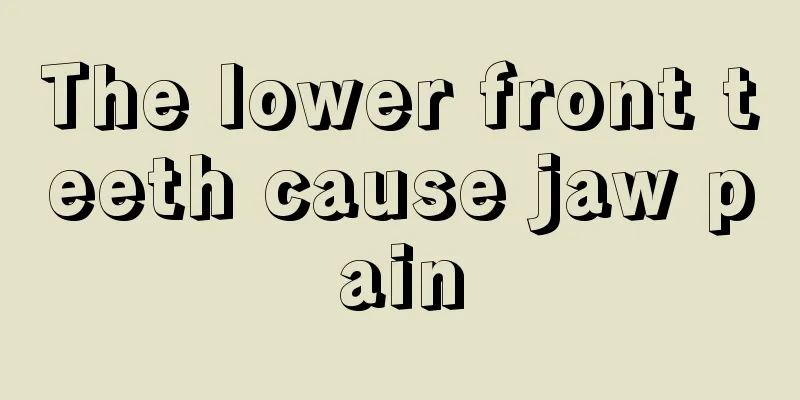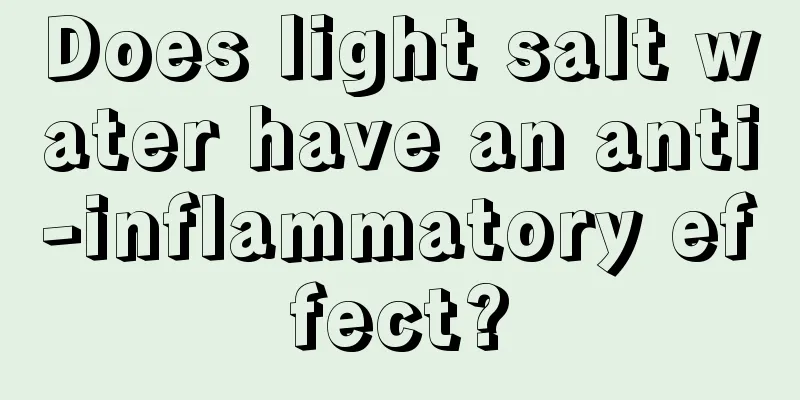The lower front teeth cause jaw pain

|
The first teeth that grow after a person is born are called deciduous teeth, but when children grow to a certain age, the deciduous teeth will loosen and fall off, and the second teeth will grow. At this time, the teeth are generally fixed in shape, so some people find that after all their teeth have grown out, their lower front teeth not only look strange, but also cause pain in their jaw. So what causes the lower front teeth to cause jaw pain? Hidden tooth cracks, also known as incomplete tooth cracks or micro-cracks, refer to non-physiological tiny cracks on the surface of the tooth crown that are often difficult to detect. The cracks in teeth often penetrate deep into the dentin structure and are one of the causes of toothache. Weaknesses in tooth structure, large cusp bevels, and traumatic forces are the causes. Causes 1. The weak links in the tooth structure are susceptible factors for the occurrence of tooth cracks. These weak links not only have low crack resistance, but are also the areas where stress is concentrated when the teeth are subjected to normal forces. 2. The larger the incline of the tooth tip, the greater the horizontal force generated, and the greater the chance of hidden cracks occurring. 3. Traumatic force: When pathological wear causes high and steep tooth cusps, the inclination of the tooth cusps also increases significantly. The horizontal component of force generated during normal occlusion also increases, forming a traumatic force that causes the enamel plate at the bottom of the pit and fissure to deepen and widen toward the dentin. This is the beginning of hidden cracks. Under the continued action of force, the crack gradually deepens towards the pulp. Traumatic force is the cause of tooth cracks. Clinical manifestations Superficial fissures often have no obvious symptoms, but deeper ones may be sensitive to hot or cold stimuli, or cause discomfort when biting. Deep hidden cracks have reached the deep layer of dentin and often have symptoms of chronic pulpitis. Sometimes they may also have acute attacks and cause fixed-point severe pain when chewing. If the above symptoms occur but no deep caries or deep periodontal pockets are found in the affected teeth, and no allergic points can be found on the tooth surface, the presence of hidden tooth fractures should be considered. Generally, a sharp probe can be used for examination. If the hidden cracks are not obvious, iodine tincture can be applied to penetrate the hidden cracks and stain them to make them clear. Sometimes placing a probe on the fissure and applying pressure or prying with force may cause pain. Grinding along the fissure revealed that the crack had reached the deep layer of dentin. Place a cotton swab on the cusp of the suspected tooth and ask the patient to bite down. If a brief tearing pain occurs, the tooth may have a hidden crack. diagnosis 1. Medical history Symptoms of chewing discomfort or biting pain are common. 2. Clinical manifestations It often occurs in bicuspids and molars, and is most common in the maxillary first molars. Careful observation may reveal light black or dark brown crack lines that may run across the tooth surface or may only be seen near the edge. There is often pain when biting a cotton swab at the fissure site. 3. Auxiliary examination Cracks can be made clearer using tincture of iodine or gentian violet. Cold testing is more sensitive at hidden cracks. treat 1. Superficial cracks without obvious symptoms and with normal pulp vitality can be treated to reduce the lateral splitting force. Prevent the cracks from deepening; you can also prepare the cavity, grind off the cracks as much as possible, and then do preventive filling. 2. For those with deeper cracks or existing pulp lesions, the cusp bevel should be adjusted extensively during pulp treatment to completely remove the fracture-causing force on the affected tooth and the tooth should be restored with a full crown in a timely manner after treatment. During the treatment of endodontic disease, surface perforation causes the crack's ability to withstand force to be greatly reduced. Even though the bite is lowered during treatment, it is very easy for the tooth to split from the crack due to chewing and other reasons. Therefore, at the beginning of endodontic treatment, a ring can be bonded to protect the crown, and a full crown restoration should be performed after the endodontic treatment is completed. |
<<: Can wolfberries still be eaten if they are stuck together
>>: The chin is a little crooked and the mouth is a little crooked
Recommend
Is drinking lotus leaf tea on an empty stomach good for your health?
Lotus leaf tea is often drunk by people who are l...
What are the common symptoms of esophageal cancer
Esophageal cancer, also known as esophageal cance...
Dietary taboos for breast cancer patients
There are no special dietary taboos for breast ca...
Is breast milk blood?
I often hear people from the older generation say...
What is the most effective way to reduce appetite?
People's appetites can be strong or weak, whi...
What are the traditional Chinese medicine prescriptions for women to nourish the kidneys
There are many ways for women to replenish their ...
What are the training methods of spring tensioner
There are many equipments that can be used when e...
What is the fastest way to cure mouth ulcers?
Ulcers at the corners of the mouth are also a typ...
How many years can a person with cervical cancer usually live
Cervical cancer is a common malignant tumor in th...
How to use Candlewood Leaves to nourish hair and what is the effect
In addition to its medicinal effects, the leaves ...
Is glioma a familial genetic disease?
Suffering from a brain tumor is a serious blow to...
What is lymphoma?
Lymphoma, also known as malignant lymphoma, refer...
What are the symptoms of liver metastasis after pancreatic cancer surgery
The number of patients with pancreatic cancer liv...
Symptoms of spraining an ankle and injuring bones
Spraining an ankle is a very dangerous thing for ...
Which lung diseases will turn into cancer? Lung cancer prevention starts from these aspects
Lung disease is a very common disease in our body...









